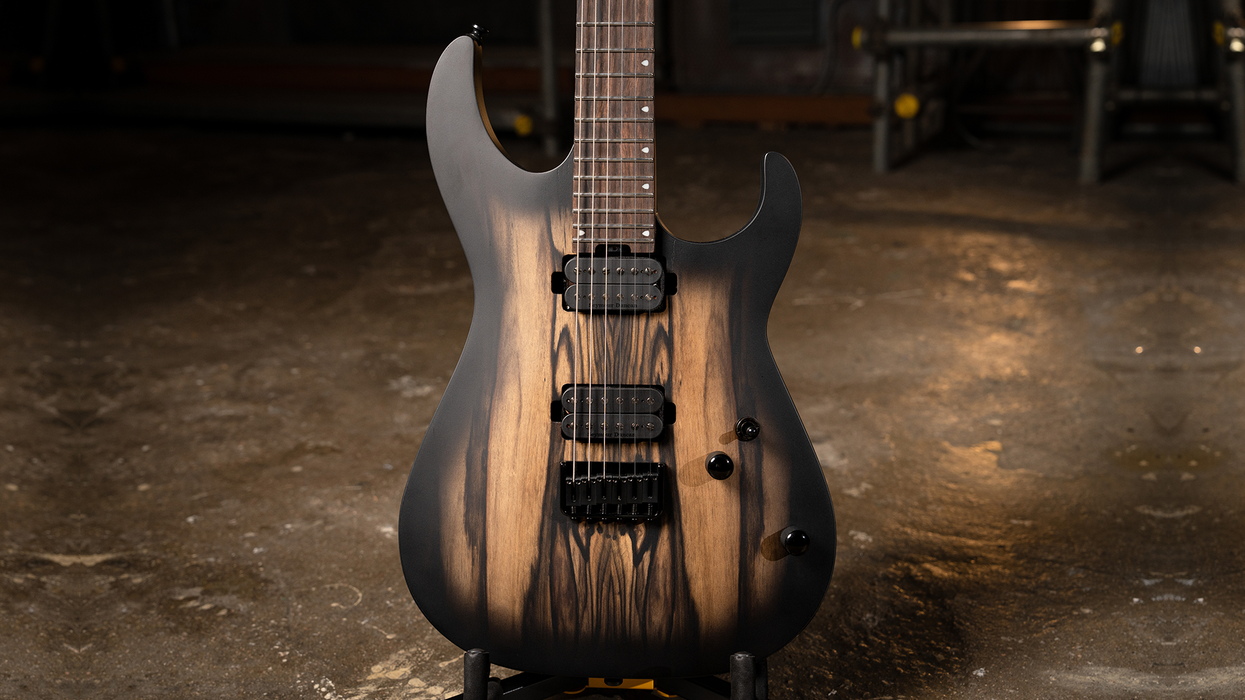The Clash lights up Boston, circa 1979. All photography by Bob Gruen
In the mid 1970s, the sounds of anger and energy collided in what came to be called “punk rock.” Punk—and its genre-spanning reverberations—changed music, and the world.
And that’s because punk is energy. Punk is anger. It’s the sound of fury, the energy of the disaffected. It was a reflection of hard times, boring places, and frustrated ambitions. The music, the look, and the attitude of the punk movement that took place in the US and UK in the “Me Decade” had a huge impact on music and culture across the globe. The primary vehicle of punk expression was music. Loud, fast, three chords. Punk was the antithesis of the hippie music that preceded it. At least it started that way, but almost as soon it began to change, grow, and expand.
To play music, you need gear. Duh, right? So let’s examine the gear used by the three primary exponents of punk music in its first days—the Ramones, the Sex Pistols, and the Clash—to see how they used it to wake up a generation.
The Ramones : Volume as a Weapon
In punk, volume is both a weapon of aggression and a tool of protection. You can command a lot of attention with 120 decibels of sonic fury. You can also make people think twice before taking a shot at you with a beer bottle or a glob of spit.
“Big tools for a big job,” is how Pete Townshend of the Who described his gear. The job was to get ideas across to people—teach them and wake them up. The tools were big amps and electric guitars. The Who’s music spoke of disaffection and dissatisfaction, and it sounded dangerous, loud, and nasty. Many would argue that the Who, four angry young men from Shepherd’s Bush, London, were the original punks. They certainly created the blueprint for punk gear. Early on, the Who struggled to get acceptable sound and volume from cheap, underpowered gear. Both Townshend and bassist John Entwistle were admirers of Fender amplifiers. By the mid ’60s they were working with British music shop owner Jim Marshall, who was building clones of the Fender Bassman circuit for the British market. Townshend and Entwistle, who had determined that their brand of aggressive music required more volume than either the current Fender or the Marshall lines could supply, requested a 100-watt amp from Marshall. The unit he delivered, the Marshall 1959 SLP100, satisfied their requirements for power, volume, and durability and became one of the classic rock amps of all time.
The Who were at the forefront of a new sound in rock and roll: distortion. The sound of tubes and speakers being pushed beyond their limits—something that, in previous generations, had been avoided at all costs— became the sound of a generation. And the defining guitar tone of the last 40 years. The tones, the overtones, and the harmonics of that saturated sound changed guitar and the way people heard it. What was once a major no-no became exactly what people wanted.
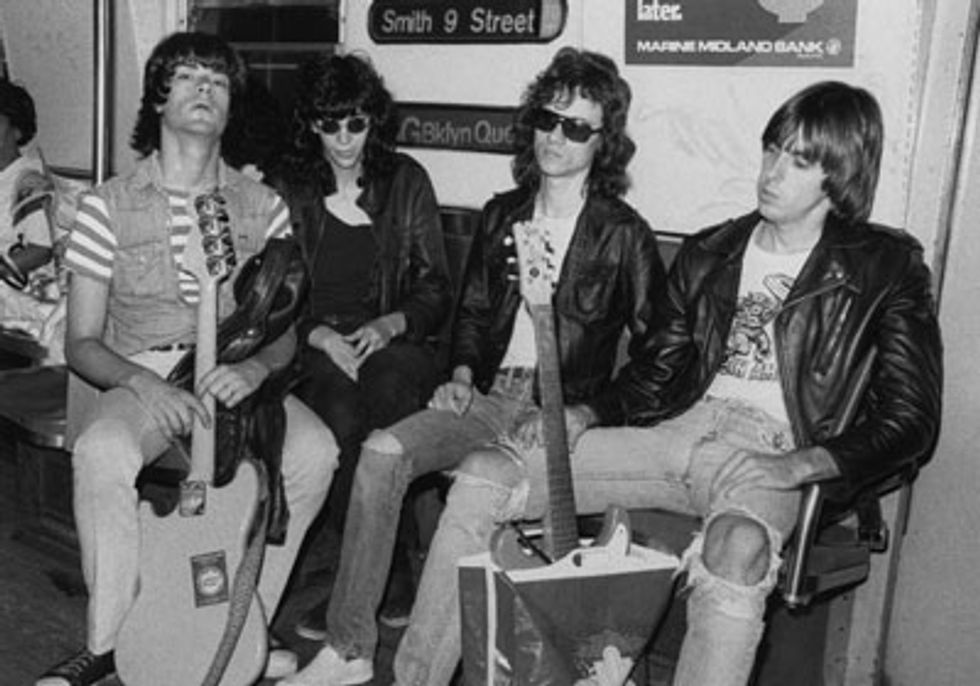 Slumming on the Subway: (left to right) Dee Dee, Joey, Tommy, and Johnny Ramone in NYC, circa 1975. Note Johnny’s gig/shopping bag. |
Like the Who, the Ramones initially struggled with underpowered gear and cheap guitars. And like Townshend & Co., the Ramones got new amps. Gone were the small combos they had struggled with. In their place were two of the all-time giants: Marshall and Ampeg.
“We play so loud that the amps couldn’t take it,” bassist Dee Dee Ramone explained in 1976 in the documentary End of the Century: The Story of the Ramones. “But now we got these amps that they…they, they’re really, they, they…work. And we can really push them. We could blow this place apart if we wanted to.”
Guitarist Johnny Ramone was a wild fan of the Who, the Stooges, and the New York Dolls. Having witnessed these bands in their heyday, he had seen first-hand the power waiting to be unleashed from a quartet of glowing bottles like a hell-bent genie trapped in a really lame lamp. So when money was finally available, Johnny purchased not one but three Marshall 1959 Mark II Super Lead heads and six Marshall 1960B 4x12 straight cabinets. For his part, bassist Dee Dee purchased three Ampeg SVT 300-watt bass heads and three matching 8x10 cabinets. Johnny and Dee Dee would stay with Marshalls and Ampegs, respectively, throughout their careers with the Ramones. Further, both played said amps at full volume. Johnny’s tone was referred to as similar to a buzzsaw.
Night after night of full-tilt operation pushed the Ramones’ amps to the limits. Monte A. Melnick, Ramones tour manager and author of On the Road with the Ramones, recalled recently, “I would have all the amps serviced before all the tours by a professional service company. They would test the tubes and change the ones they determined bad. We did carry spare Marshall tubes, and I believe they were EL84s. We had spare Marshall and Ampeg heads and cabinets with us on tour just in case we had problems. The amps and cabinets for the Marshalls and Ampegs were right out of the box with no alterations.”
Johnny relied on a Mosrite Ventures II model guitar. He often said that he went to 48th Street in Manhattan—music row—looking for the cheapest guitar he could find. This is true, but he was also looking for something that would separate him visually from the soft-rock players of the day. Made only in 1965, the Ventures II model was the company’s entry-level Mosrite guitar, and it had a basswood slab body, a thin and fast neck, plastic trim and knobs, and single-coil pickups. Johnny went through a number of Mosrites over the years, but from 1977 until the band’s last show in 1996 he played a white model with a stop tailpiece and a DiMarzio Super Distortion humbucker in the bridge position. For a brief period in the early 1980s, Johnny had a deal with Hamer and was seen in an advertisement playing a double-cutaway model with dual humbuckers, and he was spotted playing a Rickenbacker 450 on the TV variety show Don Kirshner’s Rock Concert.
Dee Dee played white Fender Precision basses with maple necks and black pickguards for nearly his entire career. Because of his rough playing style, he went through two or three basses per tour (the band routinely played 250 nights per year). In a mid-1980s interview, he described how he and his roadie would caulk the controls and cavities to keep out the sweat. Melnick disagrees: “Dee Dee never put caulk on his bass. I don’t think he knew what caulk was.”
The standard onstage guitar setup for the Ramones, from the beginning in small clubs to the end on major festival stages, consisted of three Marshall heads running five 4x12 cabinets—three stage-right, behind Johnny, and two stage left behind Dee Dee. During Dee Dee’s tenure (1974 to 1989), the classic Ramones bass rig was two Ampeg SVT heads running two Ampeg 8x10 cabs, one on either side of the drum riser. This gear enabled the Ramones to create the prototypical punk sound: rough, raw, brutal. Joe Strummer of the Clash said once about a Ramones show, “They only played for 30 minutes…because you just couldn’t take that 31st minute.”
The Sex Pistols: Debauching Fender, Gibson and Everybody Else
What happens when you turn a Fender Twin Reverb up to 10? Is it possible there was a time when having ’40s pinup decals on a guitar was considered lewd? Could rock ’n’ roll ever be so provocative as to elicit death threats from elected officials? These are serious questions when they relate to the brief, momentous tenure of the Sex Pistols—perhaps the most notorious, infamous punk band of all time. Starting even lower on the socio-economic scale than the Ramones, and making the Clash look like a bunch of rich kids, the Sex Pistols began as an anarchistic daydream of their manager, Malcolm McClaren—a London shopkeeper and raconteur looking for fame, money, and freedom. He had been exposed to the nascent New York punk scene in the last days of the New York Dolls and the early days of the Ramones. In fact, he managed the Dolls for a short period. Failing to collect monetary compensation for his duties, he took payment in the form of Doll’s guitarist Syl Sylvain’s white Les Paul custom, which he took with him when he flew back to London in 1975.
In the hands of one Steve Jones, of Shepherd’s Bush, London, that Les Paul would become the basis of the Sex Pistols sound. In the process, it also became a template for punk sound and a classic rock ’n’ roll look.
The Sex Pistols set out from the very beginning to be revolutionary, to upset the status quo, to be outrageous and to tear down the pretensions that had poisoned rock. Their 1977 album debut, Never Mind the Bollocks Here’s the Sex Pistols, coincided with the 25th-anniversary jubilee of Queen Elizabeth’s ascension to the throne, a time of extreme nationalism in Great Britain. It was also a time of great economic and social unrest. So rather than join in celebrating the Queen, the Pistols—especially frontman Johnny Rotten— chose to illuminate the problems of the country. Starting with, of course, the Queen. Their two greatest songs, “God Save the Queen” and “Anarchy in the U.K.,” were anthems of all-out rebellion, tongue-in-cheek broadsides railing against the hallowed institutions of a fast-decaying former power.
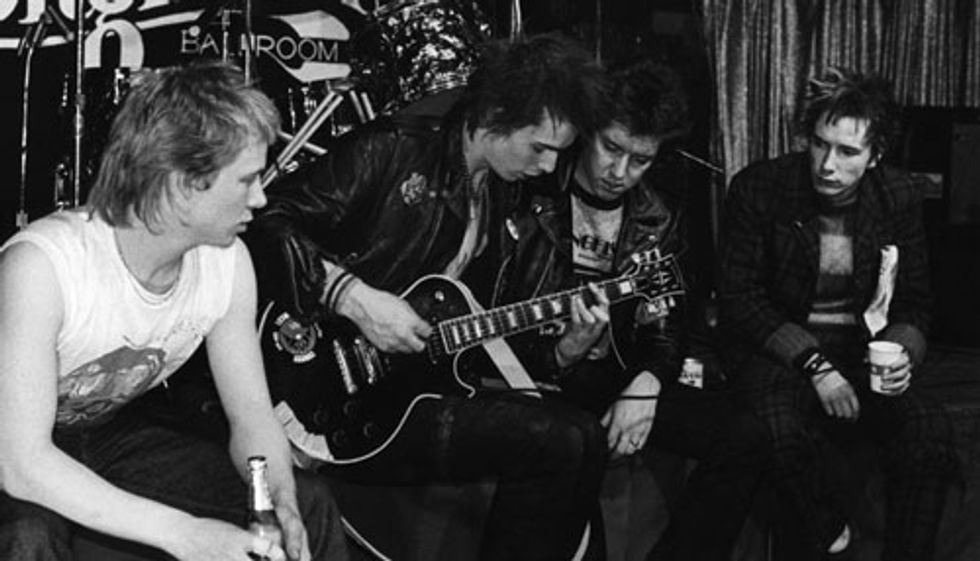
Power-Chord Powwow: (left to right) Sex Pistols drummer Paul Cook watches as bassist Sid Vicious plays Steve Jones’ Les Paul and vocalist Johnny Rotten has a cup of something.
Steve Jones possessed the two greatest attributes of a punk guitarist: limited training combined with a massive will to play. Merely three months after officially taking up guitar, he played the first Sex Pistols gig. With no time to learn, Jones developed a style based on the power-chord stylings of his two heroes—Mick Ronson and Faces-era Ron Wood. The Pistols played their first gig in September 1975, with Jones wielding the Les Paul Custom, which sported ’40s pinup decals that were considered risqué anywhere outside a mechanic’s garage calendar.
In addition to his white Custom, Jones relied on one other crucial piece of gear: a silverface Fender Twin Reverb. Jones plugged straight into the Twin for the duration of the Pistols short first chapter, and all the way until their 1996 return. The only variation in the setup was the occasional use of an MXR Flanger on “Anarchy in the UK.” Jones’ tone was all about overdrive and crunch, and the only way to achieve that using a Twin Reverb and no pedals is to turn the amp all the way up—a loud, loud proposition. Like the classic Marshalls, a Fender Twin is a 100-watt amp. Its compact size often fools people into thinking it’s a club amp when, in reality, a Fender Twin can play a large-sized hall. At full volume, the four 6L6 tubes in a Twin rattle walls and windows with a thick overdrive. For larger gigs, Jones sometimes added another Twin, a 2x12 Music Man, or a Super Reverb—all turned up to 10.
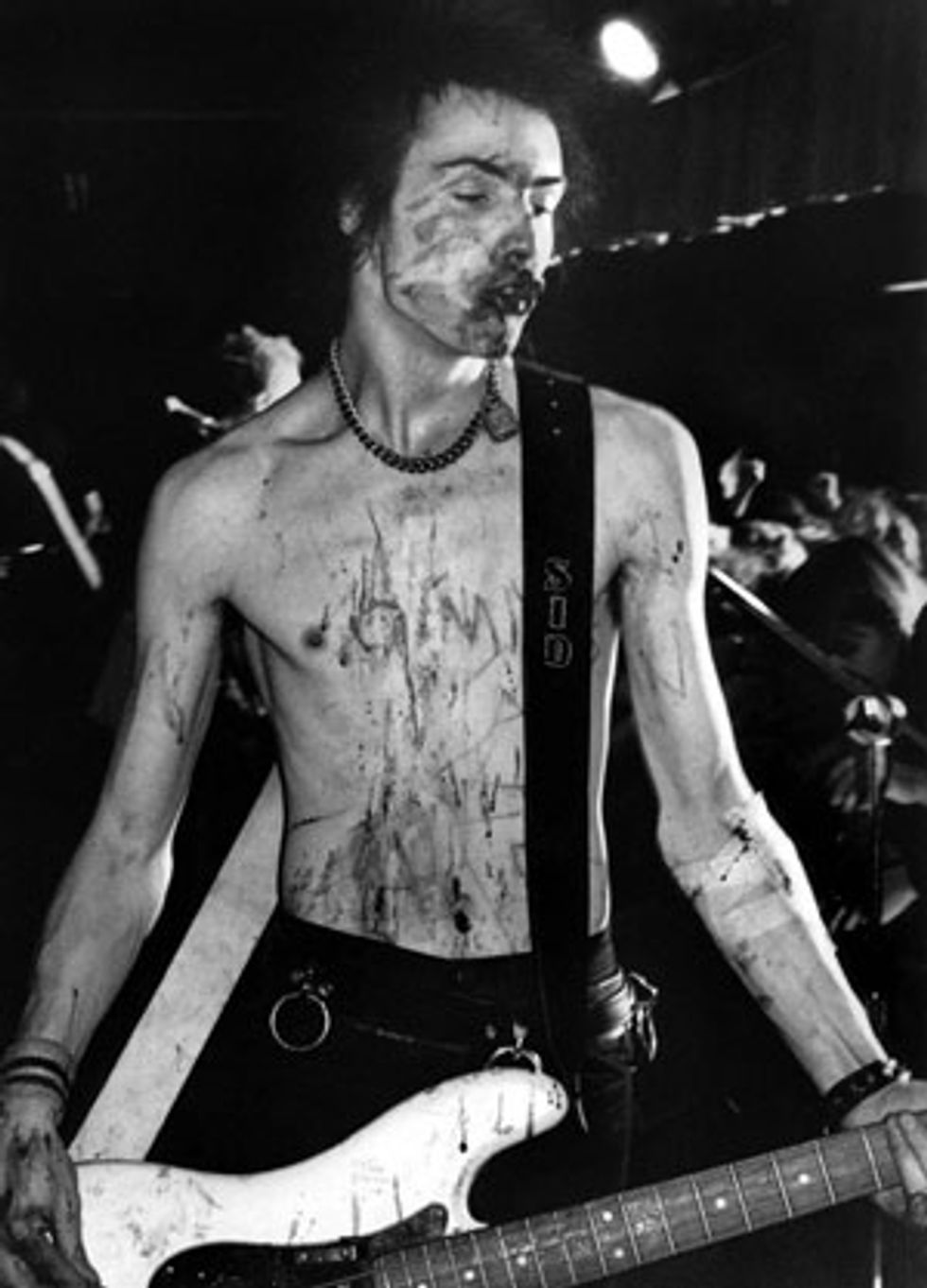 Bloody Good Show: Sid Vicious spatters his Fender Precision with nastiness, circa 1978. |
Vicious, perhaps the ultimate non-playing punk musician, picked up the bass only days before his first gig with the Pistols. He never achieved what we would call proficiency on the instrument, but he gained icon status through his look, his attitude, and his flameout lifestyle of drugs and violence. Joining the group during the recording session for their one and only album, Vicious used a rig similar to his idol, Dee Dee Ramone: a white Fender Precision bass and Ampeg SVT (although, possibly at Jones behest, Vicious was limited to a single 4x12 cab).
The sound of the Sex Pistols influenced not only future punks, but rockers and metal players as well. Guns N’ Roses based much of their sound and persona on the Pistols. And bands from Motörhead to Pearl Jam, Rancid, Blink-182, and a zillion others cite them as a major influence despite the fact that the Pistols flamed out in 1978. When they reunited in the late ’90s, they had better gear than the early days, but the sound and the fury was exactly the same.
The Clash: Sometimes Dirty, Mostly Clean
Directly influenced by both the Ramones and the Sex Pistols, the Clash added a healthy dose of roots music to the punk formula. While neither as hard as the Ramones nor as snotty as the Pistols, the Clash created a sound every bit as iconic. A major component of this was the dual-guitar approach of Joe Strummer and Mick Jones. In addition, the fact that the members came from various rough neighborhoods and squats of London brought a severe political edge to their music and, by extension, to the greater punk movement. The pointed lyrics of Joe Strummer, combined with the mod-influenced music of Mick Jones, created a sound that appealed to punks but also to fans of rock and roll.
The Clash’s eponymous 1977 debut was powered by the driving P-90s of Jones’ Les Paul Jr. By 1979, when the band was recording its third album, London Calling, the Clash became the first of the punk bands to break away from the loud/fast rules and into new styles such as reggae, R&B, and rockabilly. Along with this change came new gear and a new sensibility of how to use it for maximum effect. Jones, the lead guitarist and primary songwriter, was into creating sound textures from the band’s earliest days. But he also participated wholly in the distortion onslaught that was expected in punk’s formative years. Circa 1976 and 1977, Jones relied on a Les Paul Jr. with P-90s plugged into an Ampeg V4 head and 4x12 cabinet. His early live sound was a boxy, nasal sneer that, while capable of cutting through the mix, lacked the depth of tone to carry the band’s newer, more complex material.
So during sessions for the band’s second album, Give ’Em Enough Rope, Jones began to upgrade. First up was a switch to what would become his signature ax for the rest of his time with the Clash, the Gibson Les Paul. Jones knew a good ax and he had many, including a sunburst ’58 Standard, a wine-red ’70s Custom, a white ’70s Custom, and a sunburst ’70s Custom. On the road in America in 1979, he picked up a rare all-white Gibson ES-295 that he used for a short period. In the studio, Jones frequently played a late-’70s all-black Fender Strat with a maple fretboard. It and a new Precision for bassist Paul Simonon were gifts from Fender.
During the Rope sessions, Jones was also hipped to quality tube amplifiers—specifically Mesa/Boogies—by producer Sandy Pearlman. Jones favored the 100-watt Mark I in combo form. He unloaded the speaker and used it to drive a single Marshall 4x12. For a period he even used the Boogie to run two 4x12s, but by the end of 1979 he had added a blonde 100-watt Mark II to drive one of the cabinets. That dual half-stack setup would be his main rig from then on. However, in early 1979 Jones began moving away from the straight-ahead punk grind and toward a wide, panoramic sound that filled the spaces in the Clash’s music. He added modulation effects too, specifically the MXR Phase 100 and MXR Flanger. Soon after, Jones also discovered the Roland RE-201 Space Echo. Jones used these pieces of gear extensively, both live and in the studio, for everything from light flanging effects to deep echo.
Joe Strummer, the Clash’s chief lyricist, lead singer, and rhythm guitar player, is one of the world’s best-known Telecaster players. He favored Teles for their simplicity, durability, and American working-musician vibe. He also liked the cutting bite of their bridge pickup, a sound well matched to his brutal playing style—the surname Strummer was no accident (though it was perhaps a bit understated). Strummer’s main Tele—the subject of a recent Fender signature reissue—was a ’66 model with a sunburst finish and a rosewood fretboard. He acquired the guitar in a typically cheeky manner: Short on cash, he married a woman looking for UK citizenship in return for the money needed to buy a the Telecaster. Not quite selling your soul, but certifiably punk, that’s for sure. Strummer banged away on this ax during his years with the infamous 101ers, the hardscrabble outfit of roots rockers who came to dominate London’s mid-’70s pub rock scene that preceded its punk outbreak. When the latter came around, Strummer packed up his Tele and joined the Clash. In the spirit of the times, he had friends in an automotive shop spray his sunburst Tele black (with a hearty coat of grey primer). Strummer played this guitar until his death in 2002, although he also had a backup Tele that sported a metal pickguard and had been stripped and refinished in a natural coat.
Between 1979 and 1981, Strummer’s main stage guitar was a white-blonde, mid-’50s Fender Esquire with a slab fretboard. In typical Strummer fashion, this guitar would soon sport a number of decals and a black racing stripe.
Strummer’s tone could be summed up in one word—clean. After dabbling with a number of heads and combos, everything from a Vox AC30 to a Marshall SLP, Strummer settled on a silverface 1970s Fender Twin Reverb. He used this until the end of 1979, when he switched to a Music Man HD-150 212. His famous quote on the subject, from a 1981 Musician magazine interview, was, “I don’t have time to search for those old Fender tube amps. The Music Man is the closest thing to that sound I’ve found…that plastic motif on the front is repulsive. Those little guys in bell-bottoms. Ugh!.” Strummer found the Music Man to be durable enough to withstand the Clash’s rigorous touring, and powerful enough to provide loads of clean volume, even when driving a 2x12 extension cab. His clean tone was a singular contrast to Jones’ saturated, effects-laden onslaught. Strummer’s Music Man came up for sale a few years ago and was purchased by Strummer fan and friend, Eddie Vedder. He wanted to use the amp onstage but, alas, found it too loud and too clean. Some horses can only be ridden by one rider.
For his part, bassist Simonon paid his gear dues early in the band’s history, working a string of no-name copy instruments. As the band got more attention, Simonon acquired a Rickenbacker 4001, which he disliked. He wanted a bass that was substantial in both weight and tone. In the end, he gravitated to the same camp as Dee Dee Ramone and Sid Vicious: a white Fender Precision and an Ampeg SVT. Simonon famously smashed this bass at a show at the New York Palladium in September 1979. This moment of anger and energy was captured by photographer Pennie Smith and became the iconic cover shot of the London Calling album. And the smashed Precision eventually found its way to the Rock and Roll Hall of Fame. Unlike Vicious and Ramone, Simonon became quite proficient on his bass, mastering funk and reggae styles and following the creative path of the Clash all the way up the river to its ultimate breakup.
The Clash put the “rock” in punk rock. Unlike the Sex Pistols and the Ramones, the Clash successfully broke past the strictures of early punk to move into new genres and eventually create a signature sound. The gear the Clash used was key to this success.
Punk 2.0 and Beyond
Since his band changed the world with a stage full of cranked gear, Johnny Ramone has sold his Mosrite and Marshalls on eBay. Dee Dee’s basses and amps are long gone, sold to finance a lifestyle that eventually killed him. Jones of the Pistols still has his Les Paul, although he has a dubious history of selling and re-purchasing the storied instrument. Likewise, Strummer’s Telecaster has done time in the Rock and Roll Hall of Fame, and Mick Jones has his old axes either stashed away or in his library in London. All these instruments that played songs of rebellion and anarchy, all these amps that were run at top volume to decimate so many hearts and minds, all of it now silent.
Many generations of punk have come and gone since that first wave. Late-’70s bands, American hardcore bands, Oi! and thrash bands. The genre and all its offshoots have had innumerable adherents through the years and on down to today. As always, the punks are the ones who step out front first to rebel against the status quo. Afterward, others come through the broken window. But it’s those first pioneers, the rebels so often cast as misfits or threats to society—the punks—who are the first in.
And doing that takes energy.
Want more punk? Click next for 10 First-Generation Punk Albums You Gotta Have
10 First-Generation Punk Albums You Gotta Have
Because early punks more often than not had to use cheap gear, punk music is a cavalcade of intriguing tones and textures. As I write this, I’m listening to a shuffle that includes the Buzzcocks, Swell Maps, and the Saints. Each of these bands has a unique sound. And being different is exactly what punk is all about. Here’s a list of 10 first-generation punk albums and must-watch YouTube videos that will flip your wig with cool sounds.
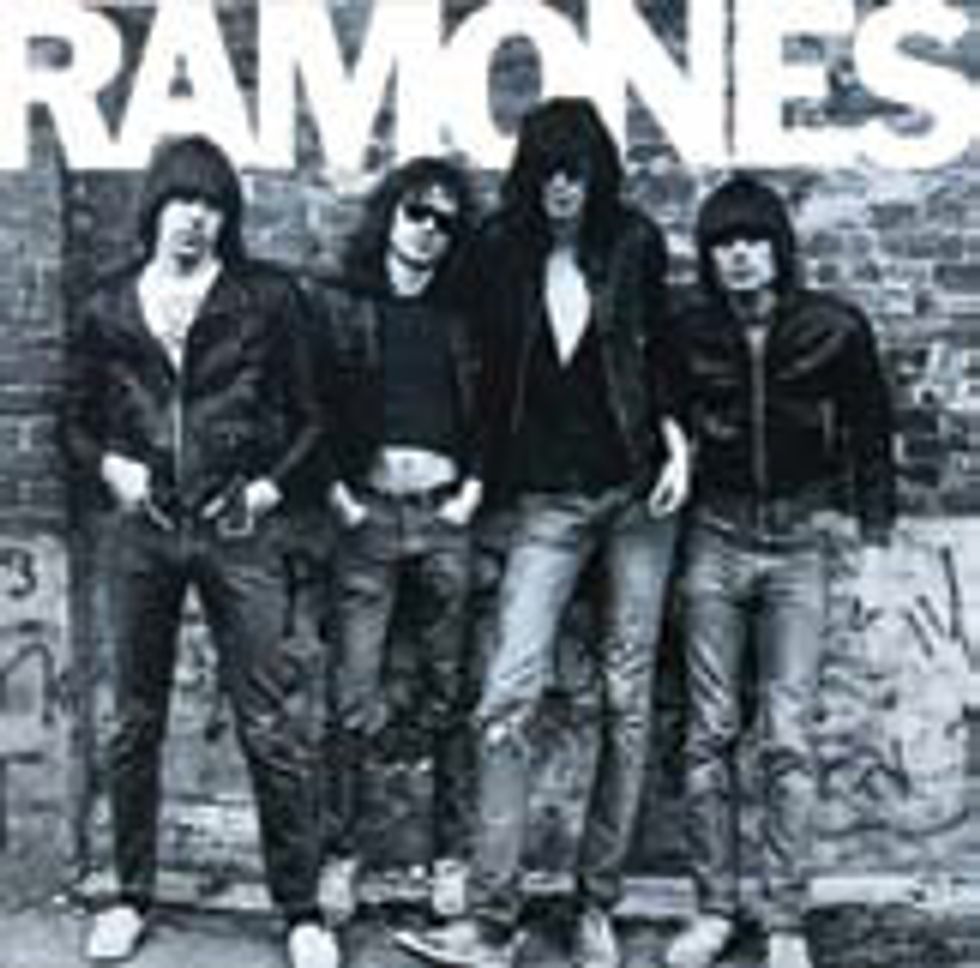 The Ramones, Ramones, 1976.
The Ramones, Ramones, 1976. The blueprint for fast, loud, raw punk. Marshalls and SVTs dimed in the studio. Ramones was so revolutionary at the time that many DJs supposedly smashed it in fear and disgust. YouTube Search Term: The Ramones- Listen To My Heart -Max’s Kansas City 08-10-1976.
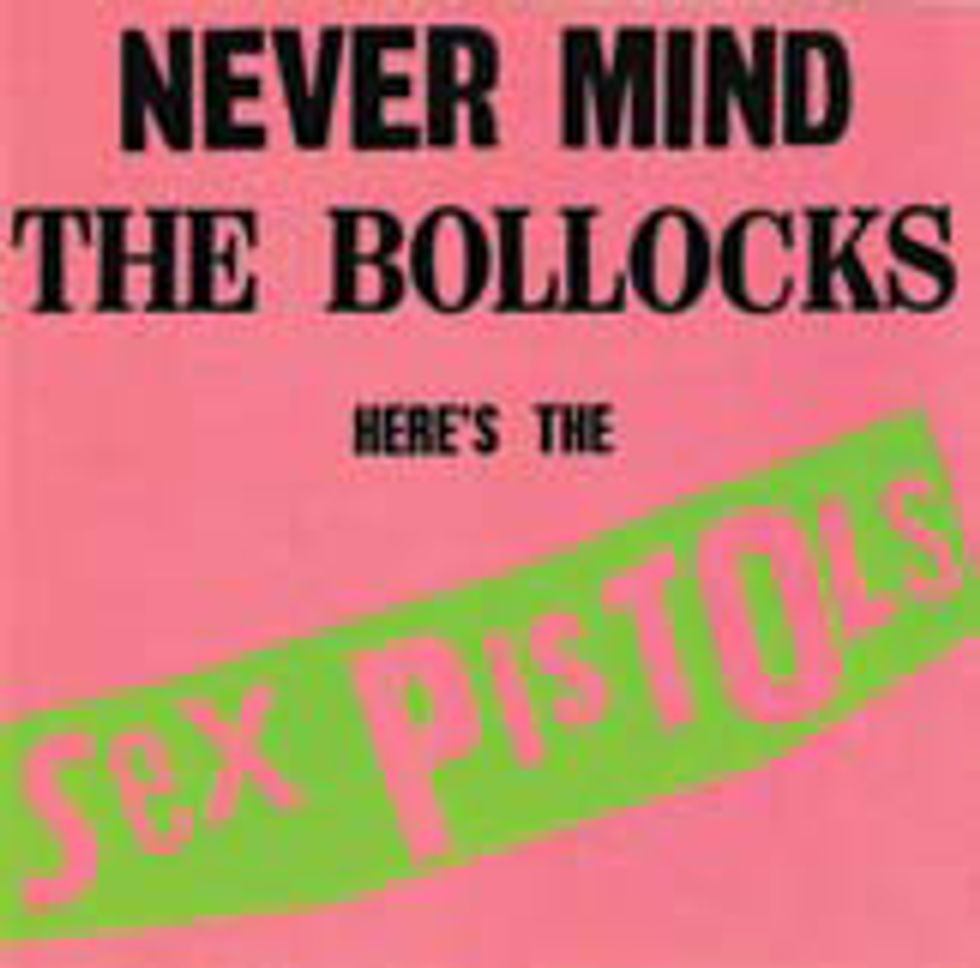 Sex Pistols, Never Mind the Bollocks Here’s the Sex Pistols, 1977.
Sex Pistols, Never Mind the Bollocks Here’s the Sex Pistols, 1977. A tour de force of guitar sounds reside on the Pistols’ one and only complete collection. Produced by Chris Thomas or Bill Price (look it up), Bollocks offers at least three different guitar tones—from fuzz to overdrive to flanged weirdness—on each track. YouTube Search Term: Sex Pistols - Anarchy In The UK (Broadcast Debut)
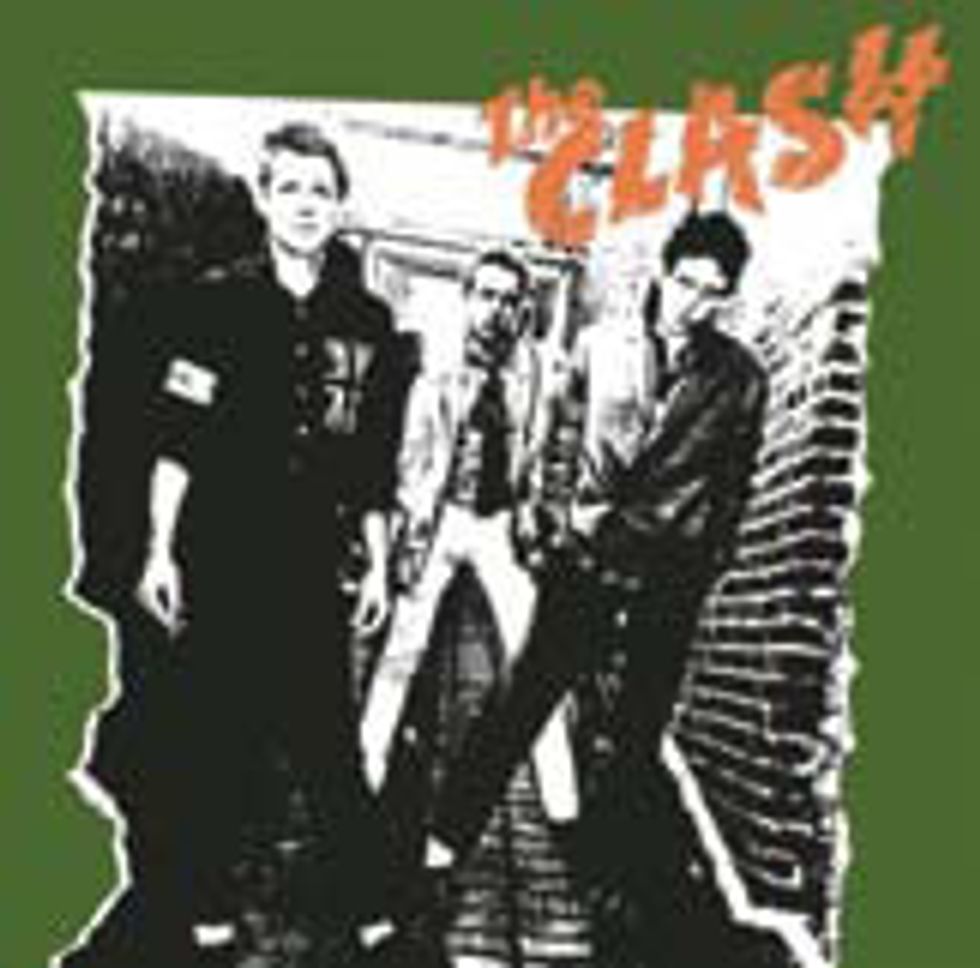 The Clash, The Clash, 1977.
The Clash, The Clash, 1977. The first album from “The Only Band That Matters” has a spare sound that makes you feel like you’re in the room with them. Mick Jones thrashes away on a P-90 equipped Les Paul Jr., emitting boxy rhythm and (dying) woman-tone leads. Joe Strummer is clearly guilty of Telecastercide. YouTube Search Term: The Clash - Clash City Rockers Live
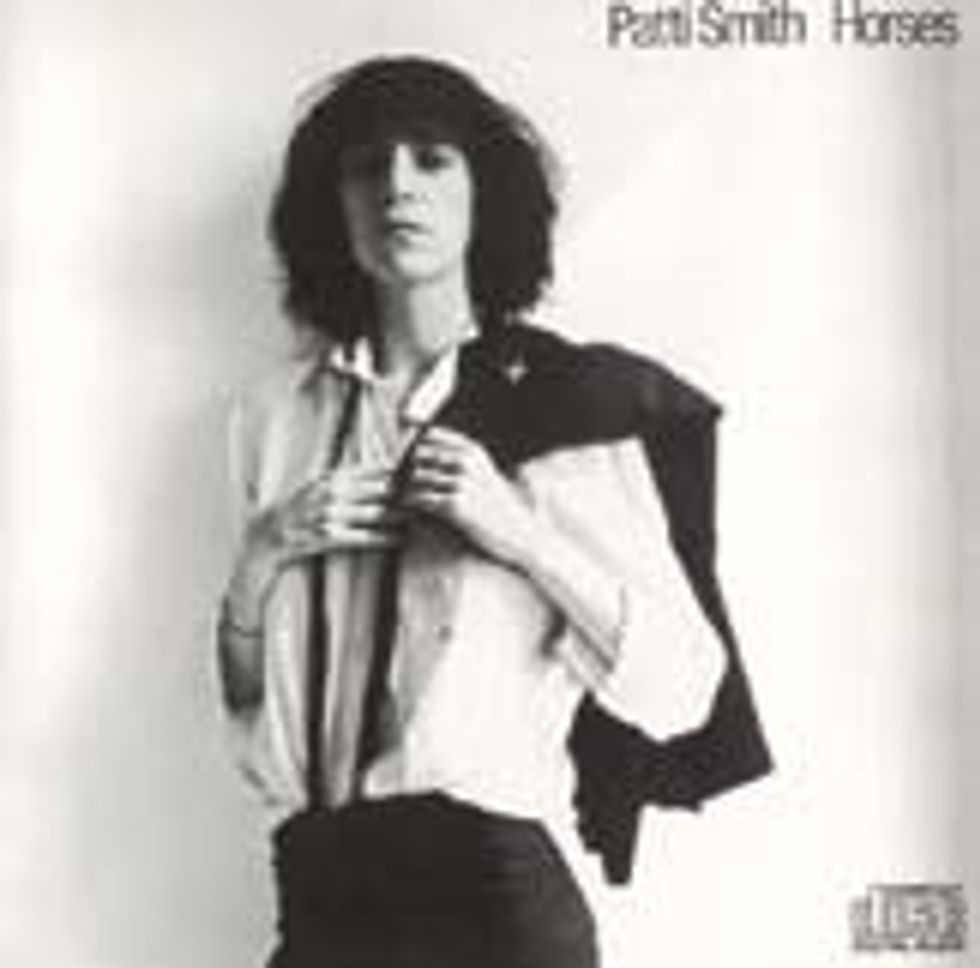 Patti Smith, Horses, 1975.
Patti Smith, Horses, 1975. Smith’s musical cohort, Lenny Kaye, knew exactly what he was doing. As the guy who compiled and documented the epochal garage-band collection Nuggets: Original Artyfacts from the First Psychedelic Era, Kaye knew punk tone inside and out. Kaye used both Fender and Gibson guitars plugged into Marshall and Fender amps. YouTube Search Term: Patti Smith - Gloria (1979) Germany
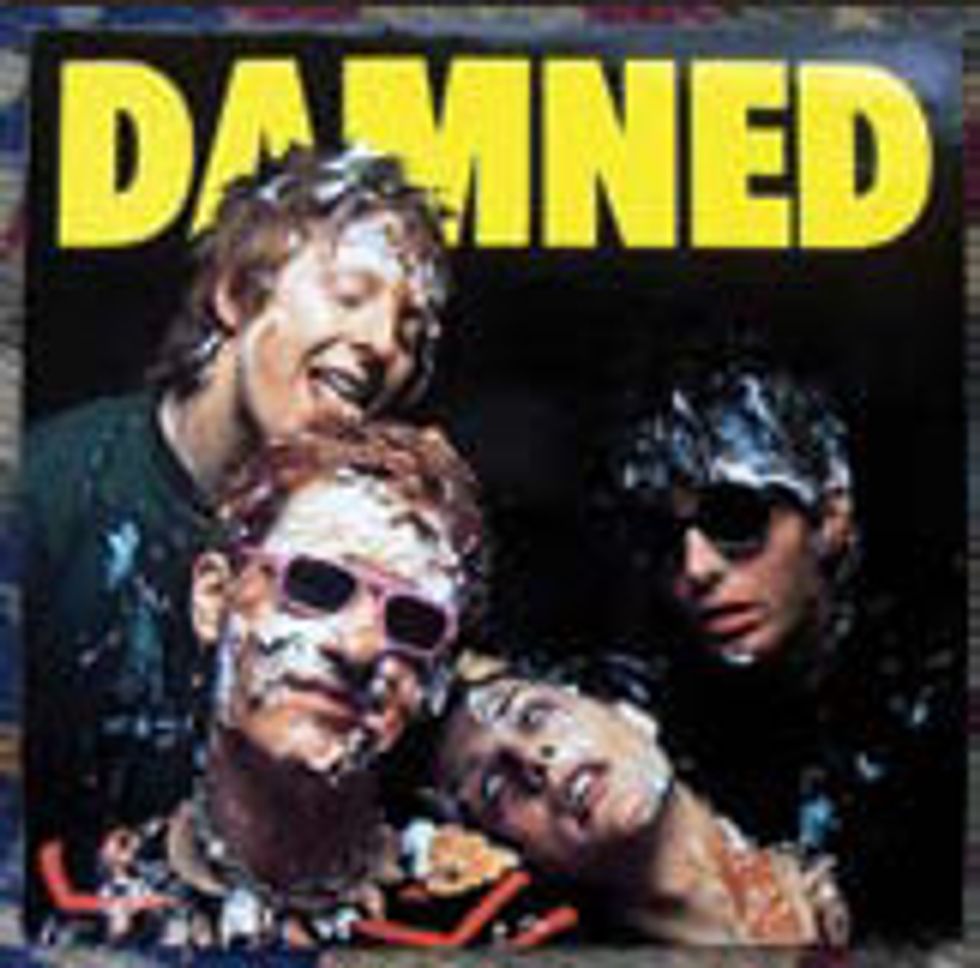 Damned, Damned Damned Damned, 1977.
Damned, Damned Damned Damned, 1977. Recognized as the first British punk album, this slab by the Damned was produced by Nick Lowe and featured punk anthems played at breakneck speed. Aggressive, barking guitar tones. Sounds like it was recorded in a shed—and it was. YouTube Search Term: The Damned New Rose
Johnny Thunders & The Heartbreakers, L.A.M.F., 1977.
Wielding his trusty Les Paul Jr., ex-New York Doll Johnny Thunders leads the Heartbreakers through a wild set of Stones-inspired punk debauchery. YouTube Search Term: Johnny Thunders & The Heartbreakers - Chinese Rocks
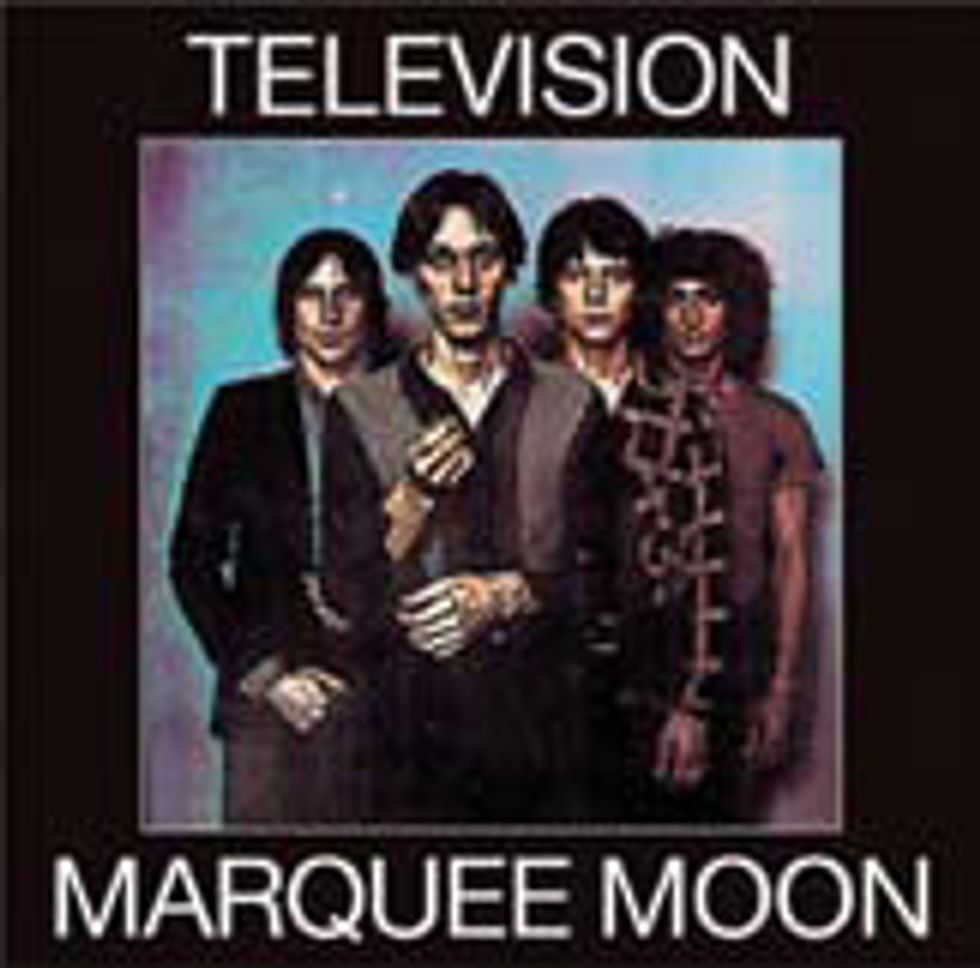 Television, Marquee Moon, 1977.
Television, Marquee Moon, 1977. Tom Verlaine and Richard Lloyd were serious guitar players who weren’t afraid to take chances. Refined Fenderesque tones mixed with experimental songwriting. YouTube Search Term: Television - Marquee Moon (1977)
Various Artists, Burning Ambitions: A History of Punk, 1982.
This hard-to-find-but-oh-so-worth-it compilation of first-generation punks provides a cornucopia of quirky, fascinating guitar tones. Buzzcocks to Blitz, this comp gives some medium-level bands deserved exposure. Highly recommended. YouTube Search Term: Buzzcocks - Ever Fallen In Love?
Various Artists, No Thanks! The ‘70s Punk Rebellion, 2003.
Want it all in one bite? Rhino’s box-set tribute to punk has every punk band you’d want to hear except the Sex Pistols—who refused just because. YouTube Search Term: The Saints - (I’m) Stranded (1977)
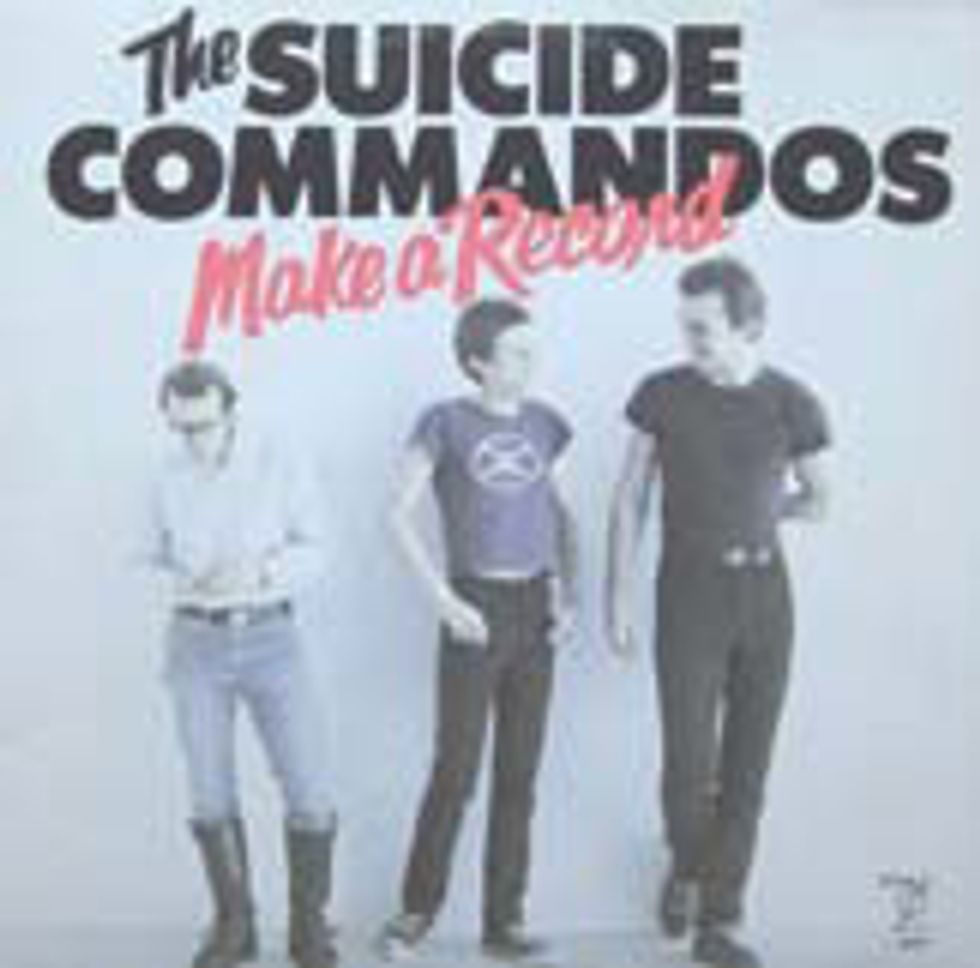 Suicide Commandos, Make a Record, 1977.
Suicide Commandos, Make a Record, 1977. Hailing from Minneapolis, the Suicide Commandos show that punk did exist outside the major metro areas. Guitarist Chris Osgood wielded a black ’52 Les Paul and grinded out some serious overdriven power. An excellent example of early, no-label, DIY punk. YouTube Search Term: Suicide Commandos - “Burn It Down”
whats-newgear-historygearhardcore-musicpunkmarshallchange-music-call-punk-rock-respanning-hard-place-ambitions-music-look-records-classic-three-primary-exponents-attention-decibels-sonic-fury-spit-townsex-pistolshardcore-punkmisfitsguitarstrummerthe-clashartistsramonesmusichardcorethe-misfitsfenderthe-sex-pistolsguitarists







![Rig Rundown: Russian Circles’ Mike Sullivan [2025]](https://www.premierguitar.com/media-library/youtube.jpg?id=62303631&width=1245&height=700&quality=70&coordinates=0%2C0%2C0%2C0)






